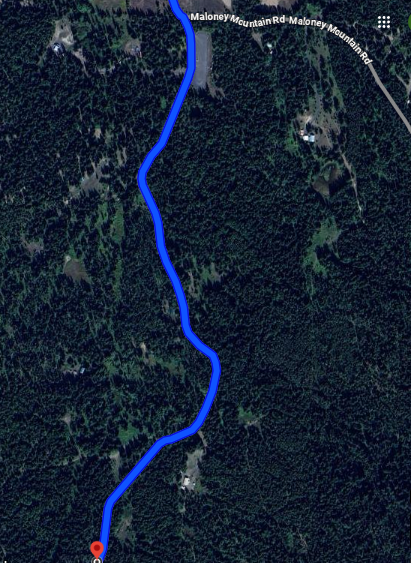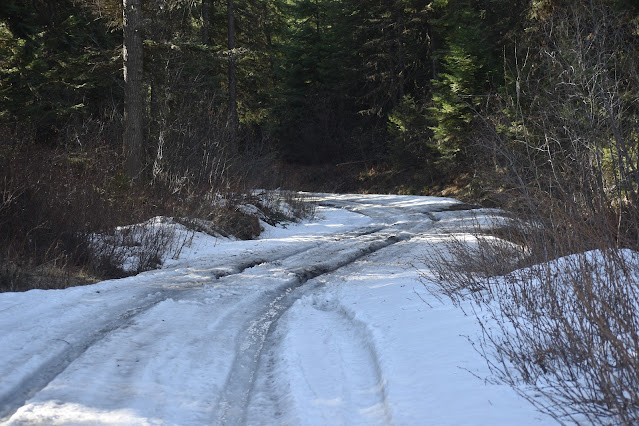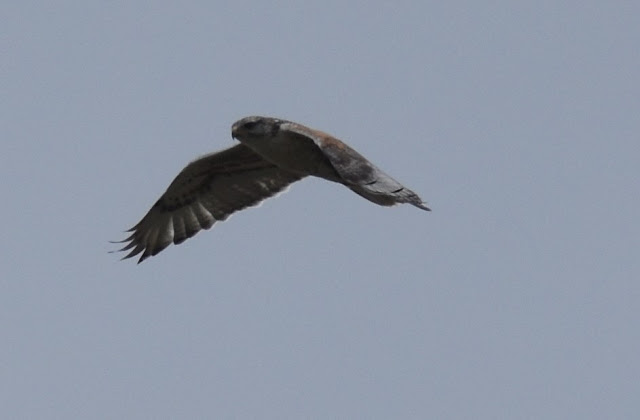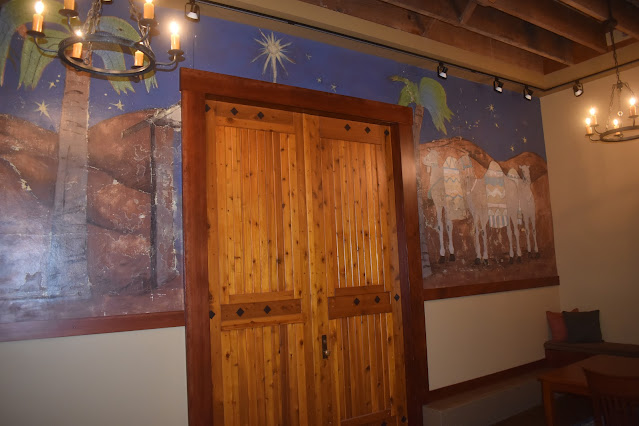75
I woke up in Dayton. 75 species under my belt for the Walla Walla year. Here in Columbia County, my January and February trips had brought me to 75. Where could I take that number?
March is a great month for water birds. They're starting to move a little, so there are increased opportunities to catch a good bird passing through (as I had with a Eurasian Wigeon the day before in Walla Walla). They're even starting to move towards breeding plumage, a nice aid should I come across some loons or grebes. And folks, Columbia County is not a great county for water birds!
With snow disappearing from the slopes of the Blue Mountains, I also had some hopes that I could make some headway on some more forest-loving birds.
I continued to book nights at the Best Western, although the 6 AM breakfast would encroach more and more into the hours when I'd rather be birding than eating rubbery eggs! The nightly rates would also almost certainly increase as the months went by.
Pittman Road
There'll be water if God wills it. I think that's how the expression goes. His Will seems to generously extend year-round to a nice little pond on the outskirts of Dayton. I picked up some American Robins, and European Starlings on the way to the pond, nothing unusual. At the pond itself, I was greeted by four (!) species of ducks. A veritable bonanza for Columbia County! While American Wigeon, Mallard, and Bufflehead had all been ticked off of my list for the year already, Ring-necked Duck (76) was a new one.
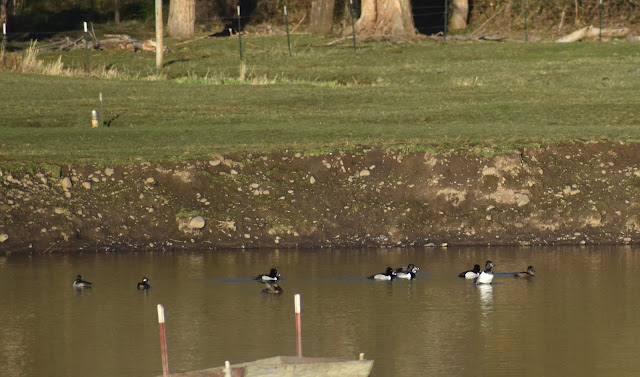 |
| Bonanza, baby! Ring-necked Ducks, and a Bufflehead |
In many parts of the state, it would even be a great time to find a Greater Yellowlegs striding the shores of this little farmland pond. But it's just far enough out of the way. Birds coming north, following the Columbia or Snake, would have to take a pretty sharp turn *away* from those rivers to land here. That, and the water was high enough - not leaving a lot of mud. I still had hopes that geography, directionality, and seasonality would lead to some shorebirds here, come spring.
Yes. . . I'm sorry Killdeer, you count as a shorebird.
Ish.
Wild Turkeys were getting flirty in the distant fields, with the males displaying and strutting around the females. I also added Tree Swallows (77), which were gliding along the distant hillsides, occasionally coming in closer to the water. The dozen-or-so Red-winged Blackbirds that seemed to be resident here had also been joined by at least one Brown-headed Cowbird (78).
Tempey Road? Timpey Road?
I've honestly seen both, between signs, GPS, maps. . . who knows? But I headed here, in search of a little more water. Peering west from the roadside (which borders Lewis and Clark State Park), I found a dozen Green-winged Teal (79) using a bit of flooded field, along with some Mallards and Canada Geese. Bewick's Wrens and Song Sparrows sung from behind me, along the shrubby/marshy ditch lining the state park. I think this is the best view of this sometimes-productive spot, but I would love to be corrected!
Dayton Fishing Pond and Park
There's always water here, but it must be the least interesting water known to duck. I can always find Canada Geese, and usually Killdeer, but all other hopes have led to disappointment here. I did not do a check of the river, which has had Common Mergansers and American Dipper in the past, but the pond itself seemed like it should be checked in March!
 |
| Double dose of "-kins" here: Catkins and Siskin |
Some Pine Siskins and a Red-breasted Nuthatch provided at least a little variety for the stop.
Highway 281
 |
| Fields along 281 |
All water for this trip. I went right for some fields that are also occasionally flooded. Milepost 6 or so seems to be the sweet spot. With some rare shorebirds that have turned up in these fields, I considered this an obligatory stop. I was not disappointed! The fields had dozens of Canada Geese and Mallards, as well as a half-dozen Killdeer. Nothing more interesting but even being able to give all of these waterfowl and shorebirds the once over made it feel like a productive stop. White-crowned Sparrow songs (Gambel's) provided the soundtrack for most of this stop.
Texas Rapids HMU to Little Goose Dam
On the way out to Little Goose Dam, I stopped here to give the river a scan. Bingo! Horned Grebes (80).
To say that these are more common that Eared Grebe (which I had found in February) isn't saying a lot! I was pretty relieved to find them. As I was listening to a Spotted Towhee (81) calling from the brush at the HMU, I heard a harsh gravelly call from the far side of the road. It took a while for me to recognize that the call I was hearing was a Chukar (82)! They're listed as a code 4. What does that mean? People don't report them every year in Columbia County. For birds that are almost certainly resident, it leads to a belief that there just arent' many of them, or that they are extremely local. I was happy to get a picture, poor as it was!
Some people had stopped at the river to do some fishing. One of them had brought a dog along, and it was *very* excited to hear the Chukar. The men talked about the birds, identifying them as Chukars without me even joining in the conversation. So, maybe not as rare as the code would imply? Who can say?
Common Goldeneyes, not new for the year, at least added to my day list, which had not been too bad for waterfowl so far.
Farther down the road, I stopped to scan some cliffs that seemed pretty birdy. Starling, Red-tailed Hawk, American Kestrel, Violet Green Swallow (83), and Canyon Wren made this worthwhile. I'm still missing Prairie Falcon for the year! So, that is a species I continue to hope for every time I do scans like this.
 |
| What is nesting here?? |
The dam itself? Canyon Wren and Western Meadowlark. And splashy water, if I need to make it more interesting! There wasn't much to look at, so I hit Riveria Road.
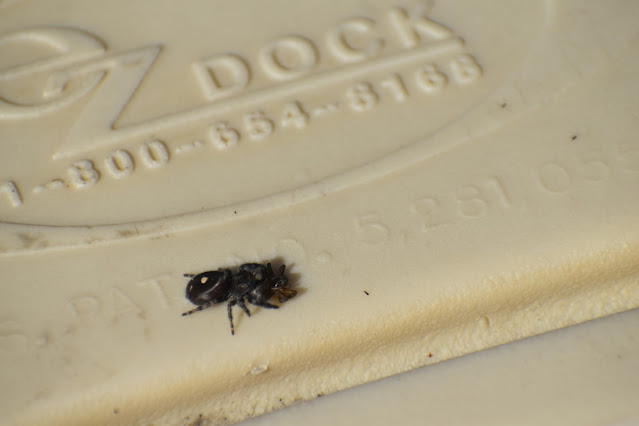 |
| Wolf Spider - from Little Goose Landing. Oh yeah! I looked there. Nothing notable. |
Riveria Road
It's not Riviera Road. . . read that carefully. In my head, I really want it to be the latter, but I'm almost to the point where I can say the actual name of the road aloud. My big hope here (in addition to Prairie Falcon, or Rough-legged Hawk), was a Ferruginous Hawk. Years ago, I had come across one on this road, and I'd actually photographed one the day before (and spent a lot of time confirming the field marks). So, I was *ready* for that hawk!
Ravens... Horned Larks... Western Meadowlarks...Oh, and cows.
It got a little interesting with Red-tailed Hawks added into the mix, giving me a chance to scan them for the red tails, belly bands, and that dark bar/patch between shoulder and wrist underneath. Nope.
I finally hit the turn where Riveria Road hits Highway 281 and turned south on the highway to head towards the mouth of the Tucannon. And a Ferruginous Hawk flew over the road. 84! I checked field marks as I pulled over, confirmed them from the side of the road, then hopped out to get a picture as the bird dipped under a slope and out of view. Satisfying at least that it was so close to the spot where I'd previously found this species!
Tucannon River Mouth
Time for another hike! This 1.5ish mile walk is a slog in places, but leads to one of the best water views in all of Columbia County. I had picked up some good waterfowl in February, and I was hopeful for more today.
What a great walk! On my last trip, I'd been chaperoned by a gregarious Downy Woodpecker (who I'd given the playful moniker "Robert Downey Woodpecker". This time? Butterflies! Along the whole walk, I had Mourning Cloaks flitting around in front of me. It felt like the same two, but there had to be at least a half-dozen visible along the walk.
Rock Wren (85) was the first new bird for the year list, calling from the rocky slopes surrounding the river valley. Near the end of the walk, Marsh Wrens (86) made it a four-wren day, along with Bewick's and Canyon. I'd seen Pacific Wren here in February, so I'd just have to come back in the summer to complete the sweep with a House Wren!
At the mouth itself, I got plenty of waterfowl once more. Pied-billed Grebe, Canada Geese, Gadwall, American Wigeon, Mallard, and Bufflehead - all seen previously - as well as a pair of Northern Pintails (87) that popped out from around some tall riverside reeds.
Both American and Lesser Goldfinches called from overhead and from trees throughout the entire walk. Like... every time I go there, they are plentiful! Wild Turkeys (seemingly everywhere), called from the hills as well.
 |
| Many-a-duck |
I tromped back and got my obligatory cup of coffee in Starbuck. I arrived around 2 and sadly missed the lunch offerings (soup and sandwiches). Some month, I'm going to get this timing correct.
Sir, would you like some more water?
Nope. No. At this point, I wanted to get UP. Exploring Tucannon Road as far up as it would take me. I had mapped out roads where good birds had been seen - ones where I saw lists from Very Good Birders, which left me wondering if other additionally cool birds had been seen but had to go unreported. In a county where Great Gray Owls are seen, but must be reported invisibly on eBird, I wanted to get a look at the habitat in the lower reaches of the Blues.
Tucannon Road, mind you, is a long road! I took it all the way up to Tucannon Campground and started my birding there.
For perspective, here's the view of my path from Starbuck. The route shown goes all the way to Panjab Campground - a good landmark for explaining where I actually went:
Interesting that it shows that other route through Dayton, yeah? More on that to come. But now that you see generally where I was going, let's zoom in another step:
This layer shows that when you pass the Fish Hatchery, you're getting close-ish! Another step in:
This layer is nice because it shows Panjab Campground - I did drive up there, and it looks like a great place to camp! As well as Ladybug Campground - I didn't go that far. And it gives perspective for where I DID go:
Maybe it'll take some squinting! But Google Maps labels this as FR-4620. My car's GPS? Maybe my road map? Maybe signs?? Had this labeled as "Turner Grade Road". It is worthwhile, at any rate, to expect *either* designation. I took the light blue all the way to the edge of this image, and no farther.
I got some chickadees, some nuthatches, some flickers (everywhere... everywhere flickers) in my various stops, but no new birds until that later stretch. Admittedly, as that road starts to wind, there were some rocks to dodge in the road! One of those rocks, I did not dodge. And I got to learn exactly what my car's clearance is not. THUNK. THUNK. The car continued driving - perhaps more than I deserved.
Heard, but not seen - Mountain Bluebirds! (88) I didn't expect these to be a challenge during the year, but it was just nice to get into their habitat finally. Also, as I tried calling for Northern Pygmy Owl, I got some responses from Steller's Jays (89). That I'd not come across a single one for the year felt surprising to me, but the elevation and tree cover definitely made it more welcoming for them here.
Way up slope, I heard another bird, much rarer than those other two. I was happy to get some craptastic pictures to document them. Clark's Nutcracker! (90). As a code 4 bird, I was sure that they'd end up on my geez-I-dunno list later in the year, but here they were, giving their nasal calls from the hillside.
Great Gray habitat?? I think maybe not? As I look more and more into it, I think the pros (open habitat surrounded by forest, and lots of perches) were outweighed by the cons (no real meadows - just steep slopes). So, I don't think I'd go back here for them. Still, what a lovely place to take in some mountain birds that I'd just missed so far for the year!
The road ahead was far from drivable! So, I returned down Tucannon Road until I got to Hartsock Grade Road. This road took me to Patit Road, which was paved and enticing! Big open fields, bordered by deep forests. Mix of farmland and undeveloped areas. I really thought I might find a Rough-legged Hawk along this stretch, but alas no. During one stop, however, I was able to listen to singing Cassin's Finches - much like Purple Finches, but drier - less sweet - if we can turn birdsong into wine for a minute. They taste the same sometimes, I swear. 91 for the year list!
Back to Dayton, dinner at Buckwheat Brewing, and off to bed with me - within spitting distance of 100 species for the year!


